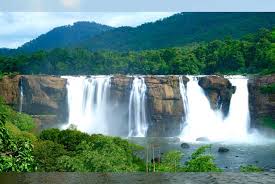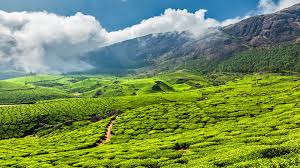A Chequered History
Enraged by the arrogance and excesses of the early Kshatriya kings, Lord Vishnu assumed the form of Parasurama (avatar of Rama with the axe), and swore to annihilate 21 generations of them. However, once this mission was accomplished, rivers of blood began to flow over the land, making it unsuitable for Brahmins to live on. Overcome with remorse, Parasurama threw his axe into the sea. Where it landed, the waters dutifully receded to create a narrow strip of land, forming Kerala. This myth may be fanciful, but it is a fitting explanation nonetheless for the birth of a land that has come to be known as 'God's own country'. The sobriquet is not linked to the myth however, but to the captivating charms of the region.
The name 'Kerala' is derived from keralaputra or the 'Land of the sons of the Cheras', who were the very first rulers of Kerala. Wars have raged over this coveted land since very ancient times. The neighbouring Cholas engaged the Cheras in battle since as early as 985 AD. Later, local principalities emerged as power centres. Foremost among them was a group of Samoothiri Brahmins, who soon gained control of the region's famed spice trade. The new rulers (later anglicised as Zamorins'), who established their capital In the port city of Kozhlkode, grew to be the wealthiest in the entire sub-continent and had trade links with the Arabs, Jews, Romans and the Chinese, Later, the Portuguese, who first came as traders, begun to covet, the land more than its spices. Subsequently, the Dutch and later, the British, waged endless wars against the Portuguese and the local Rajas. By the early 17th century, the British had gained control over vast stretches of the land and the spice trade. They went on to rule the subcontinent for over 200 years Until India gained independence in 1947.
Unlike Any other Place
The beaches of Kerala had begun to attract European guests of the Travancore kings from the early 1930s, Although tourism had been an unknown concept then. However, within three decades, the coast began to see-a transformation. Kovalam is a typical example. It had been Utile more than a sleepy coastal village until the 1960s, when backpackers and 'hippies' began to discover the charms of its southern beaches. Before long (1972), the Slate Tourism Department took over the summer palace of the Travancore royal family, the Halcyon Castle, and converted it into the first five-star hotel in Kovalam. Today, Kovalam has few equals as a seaside tourist destination. The story is similar in other parts of Kerala - the famous backwaters, the virgin forests and the green hills.

Amazing Waterways
Kerala has an extensive network of waterways that lace the interior coastline, from Hosdurg in the north to Thiruvananthapuram in the south, covering a distance of 560 km. Besides the large inland lakes that dot the land, the backwaters include the entire network of canals, estuaries and water bodies formed by the inimitable craftsmanship of nature. The waterways pulsate to a different beat, and are characterised by a lifestyle and ethos non-existent elsewhere in the country.
Kumarakom is typical of this water world. With its backdrop of rich green paddy fields and still grey waters, the region is resplendent in scenic beauty. The many resorts that have sprung up in and around Kumarakom have transformed this once quiet and peaceful settlement into a much sought after destination.
Mottled Midlands
The midlands too, are not to be ignored. Except for the absence of sandy beaches, this region appears to be an encapsulation of all that Kerala stands for. It is known for its undulating hills, flat valleys with extensive rubber plantations, a tract of forest that is one of the finest wildlife reserves in the country, panoramic backwater stretches, lush paddy fields, and a vibrant trading community with great economic clout.

Ecological Hotspots
There Is plenty for nature lovers and wildlife enthusiasts to do in Kerala, such as exploring the innumerable national parks and wildlife resorts. Located along the western corner of the Nilgiris, Silent Valley National Park constitutes one of the last vestiges of an undisturbed tropical evergreen rainforest. With an unbroken ecological history, continuously evolving for millions of years, this is a unique region. It has been termed an ecological island, one that contains immense biological and genetic wealth. Thanks largely to its difficult terrain and remote location, Silent Valley remains pristine and untouched.
Places such as Thekkady conjure up images of nature at its purest- undulating hills, crisp, clean air, and spice-scented plantations. Then there are the elephants - one of India's finest wildlife reserves is situated in Thekkady's Periyar forests. The first in the State to promote environmental tourism, Thekkady continues to beckon the adventurous traveler. Many other well protected pockets of wildlife elsewhere in the State draw visitors for the variety of local fauna and the captivating greenery.
The Western Ghats

Virgin beaches, languid backwaters and lush tropical vegetation are not the only attractions of Kerala. There are regions with cool climes and hilly environs that wait to be savoured. The Western Ghats offer cool, misty mountains, undulating meadows and picturesque valleys where vast areas are given over to plantations of tea, coffee and cardamom. The rolling High Ranges form a demarcating line at the eastern edge of Kerala, separating the State from its neighbours. The dense forests, extensive ridges and deep ravines of the Ghats have always sheltered Kerala from mainland invaders. These highlands, with their meandering roads and magnificent waterfalls, have also bestowed upon this region an ambience that is completely different from the State's other scenic locales. Remote yet easily accessible from any part of Kerala, each destination here is known for its own quaint charm.
Art, Culture and Celebrations
Art and culture have always been integral to Kerala. The pluralist aspect reflected in the art forms of the State is rooted in the rituals of its indigenous people. Among the dance forms that have evolved from ancient customs, the most prominent are surely the theyyam of northern Kerala and the pudayani of south central Kerala, Although koodiyattam and kathakali are classical forms once favoured by the elite, they now represent quintessential fiance forms of the region, An Interesting feature of the dances of Kerala, excluding the folk forms, is the strong influence of kalarippayattu, a physical discipline that was followed irrespective of gender.
Kerala, is also a land with a variety of celebrations that transcend regional and religious boundaries. What stands nut is the thread of harmony that runs through the different ceremonies and rituals. The most spectacular event of all, Onam, epitomises a newfound vigor and optimism about life. The festival celebrates the return of King Mahabali, who is believed to visit his subjects every year. To convince their beloved king that Kerala is still the land of milk and honey, people decorate their homes and celebrate to the fullest, sometimes even faking prosperity, to present a happy facade for their king.
Ayurveda
Ayurveda, the Science of Life, is perhaps the oldest and definitely, the most holistic, medical system available to the contemporary world. Although it is practised all over India, Kerala is perhaps the only State where this science still follows ago-old traditional laws. Situated in the tropical region, the State has an unparalleled wealth of herbs and natural vegetation. Although similar plants are perhaps found in the Himalayas, those found in Kerala have a special potency due to the State's unique geographical position and tropical climate. What is more, the hot and humid climatic condition of the region is regarded as specially favourable for ayurvedic treatments. In fact, the practitioners of Ayurveda in Kerala have evolved their own special formulations that are considered particularly efficacious.
Architectural Heritage
Kerala possesses a distinctive architectural style. Tiled roofs and gables, with spires, are ubiquitous. However, structures rarely rise above the first floor. Wood was used extensively not only on doors and windows, but even to make solid, carved walls. The numerous palaces, temples, churches and mosques dotting the State showcase this traditional style. However, the heavy solid wood with brass embellishments, used earlier on doors and windows, is rarely used these days, if at all.
Kerala Districts
- Thiruvananthapuram
- Kollam
- Kottayam
- Alappuzha
- Idukki
- Pathanamthitta
- Ernakulam
- Thrissur
- Palakkad
- Malappuram
- Kozhikode
- Wayanad
- Kannur
- Kasaragod

